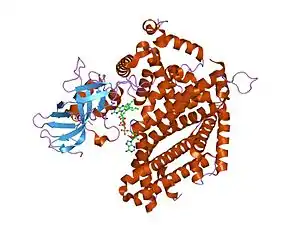Acyl-CoA oxidase deficiency
Acyl-CoA oxidase deficiency is a rare disorder that leads to significant damage and deterioration of nervous system functions (neurodegeneration).[1] It is caused by pathogenic variants in ACOX1, which codes for the production of an enzyme called peroxisomal straight-chain acyl-CoA oxidase (ACOX1).[1] This specific enzyme is responsible for the breakdown of very long chain fatty acids (VLCFAs).[2]
| Acyl-CoA oxidase deficiency | |
|---|---|
| Other names | ACOX1 deficiency |
 | |
| Acyl CoA oxidase enzyme | |
| Specialty | Medical genetics |
Defective function of the ACOX1 enzyme prevents proper breakdown of these VLCFAs, leading to accumulation and interference with the nervous system.[1][2] Acyl-CoA oxidase deficiency affects a person from birth, and most newborns affected with this condition will not survive past early childhood.[1] Affected individuals can be born with hypotonia, seizures, and dysmorphic features, such as widely spaced eyes, a low nasal bridge and low set ears. Polydactyly and hepatomegaly have also been described.[1] Most babies will learn to walk and begin speaking, before experiencing a rapid decline in motor function between the ages of 1 and 3.[3] As the person ages, and the conditions worsens, they begin to experience exaggerated reflexes (hyperreflexia), more severe and frequent seizures, and gradual loss of vision and hearing.[1][2] There is no cure for this condition, however there are a range of symptom-based treatments, used to provide supportive care.
Signs and symptoms
Children are born with this condition and their symptoms can be seen immediately.[2] In the early stages these can appear quite mild; weak muscle tone (often extreme hypotonia), lack of neonatal reflexes, seizures and abnormal (dysmorphic) facial features such as widely spaced eyes, a low nasal bridge, low set ears and an abnormally large forehead.[1][2] Due to the nature of the disease, in the build-up of VLCFAs, symptoms worsen progressively over time.[4] Children can often reach the stage at which they begin to walk and talk, before experiencing a rapid decline in motor skills due to demyelination and subsequent nerve damage.[2][3] A hearing deficit may develop, eyesight and response to visual and physical stimuli begins to diminish and eventually becomes non-existent.[1][2] The life expectancy of an individual with ACOX1 deficiency is 5 years.[2][3]
Genetics
Acyl-CoA oxidase deficiency is an autosomal recessive disorder that is caused by biallelic pathogenic variants in ACOX1.[1][5] This is the gene that codes for the production of an enzyme called peroxisomal straight-chain acyl-CoA oxidase which is responsible for the breakdown of VLCFAs.[1][2] It is not completely clear how the build-up of these VLCFAs causes the symptoms seen with this condition, however research suggests that this abnormal accumulation triggers an inflammation in the nervous system which leads to demyelination.[1] Demyelination leads to the loss of white matter, leukodystrophy, in the brain and spinal cord.[1][5] It is this leukodystrophy that is related to the development of neurological abnormalities in people with Acyl-CoA oxidase deficiency.[5] Acyl-CoA oxidase deficiency is an extremely rare condition.[1]
Diagnosis
Diagnosis can be done both prenatally based on family history and after birth based on clinical suspicion.[1][5] The primary prenatal diagnosis techniques involve the assessment of amniotic fluid for an abnormal elevation in VLCFAs, and a reduced presence (or in some cases complete absence) of acyl-CoA oxidase in fibroblasts. If the causative variants in a family are known, prenatal diagnosis can be performed by molecular testing.[4] After birth, there are a number of diagnostic techniques available for use. A blood sample can be taken, from which the serum levels of VLCFAs and acyl-CoA oxidase activity can be assessed. Analysis of VLCFAs is important for the identification of ACOX1 deficiency, if a leukodystrophy has been identified[5] Since the condition is genetic, and is caused by pathogenic variants in ACOX1, it can be confirmed by sequence or copy number analysis.[1] Due to the rarity of this condition, people who have it may not be diagnosed early in their disease progression. As a result, acyl-CoA oxidase deficiency may be misdiagnosed as similar conditions such as Usher syndrome and neonatal adrenoleukodystrophy.[5][6]
Treatment
There are no cures for ACOX1 deficiency, supportive care is used to manage specific clinical symptoms for affected individuals.[1] Treatment is based upon symptoms, with the aim the provide some relief.[5] Pharmacologic agents are used to help improve muscle tone (management of dystonia) and to block neurological signalling to the muscle. Physical therapy is used to improve movement and function.[5] For the specific treatment of recurrent seizures, there are both pharmaceutical and surgical options.[5]
References
- "Peroxisomal acyl-CoA oxidase deficiency". Genetics Home Reference, NIH. October 23, 2018.
- Thomas, Janet A.; Lam, Christina; Berry, Gerard T. (2018). "Chapter 23: Lysosomal Storage, Peroxisomal, and Glycosylation Disorders and Smith–Lemli–Opitz Syndrome Presenting in the Neonate". Avery's Diseases of the Newborn (Tenth ed.). Elsevier. pp. 253–272.e3. doi:10.1016/B978-0-323-40139-5.00023-1. ISBN 978-0-323-40139-5.
- Aubourg, P; Wanders, R (2013). Peroxisomal disorders. Handbook of Clinical Neurology. Vol. 113. pp. 1593–609. doi:10.1016/B978-0-444-59565-2.00028-9. ISBN 9780444595652. PMID 23622381.
- "264470 - Peroxisomal Acyl-CoA Oxidase Deficiency". OMIM, Johns Hopkins University. September 9, 2008. Retrieved 2018-10-25.
- Vanderver, Adeline; Tonduti, Davide; Schiffmann, Raphael; Schmidt, Johanna; van der Knaap, Marjo S. (6 February 2014). "Leukodystrophy Overview – RETIRED CHAPTER, FOR HISTORICAL REFERENCE ONLY". Leukodystrophy Overview. PMID 24501781.
{{cite book}}:|journal=ignored (help) - Parikh, S; Bernard, G; Leventer, RJ; van der Knaap, MS; van Hove, J; Pizzino, A; McNeill, NH; Helman, G; Simons, C; Schmidt, JL; Rizzo, WB; Patterson, MC; Taft, RJ; Vanderver, A; GLIA, Consortium. (April 2015). "A clinical approach to the diagnosis of patients with leukodystrophies and genetic leukoencephelopathies". Molecular Genetics and Metabolism. 114 (4): 501–515. doi:10.1016/j.ymgme.2014.12.434. PMC 4390485. PMID 25655951.